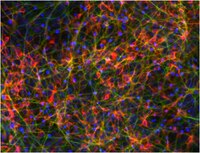GF146 Sigma-AldrichWnt-5a Protein, Recombinant mouse
The Wnt5a protein is a 352 amino acid protein containing 23 conserved cysteines & contains a cysteine modified by palmitate which is essential for receptor binding & biological activity.
More>> The Wnt5a protein is a 352 amino acid protein containing 23 conserved cysteines & contains a cysteine modified by palmitate which is essential for receptor binding & biological activity. Less<<Recommended Products
Overview
Key Specifications Table
| Key Applications | Source | Purity |
|---|---|---|
| CULT | Wnt5a has been purified from conditioned media using blue-Sepharose™, gel filtration and heparin affinity chromatography. | Not determined. Endotoxin level is less than 0.1 ng per μg of Wnt5a. |
| Product Information | |
|---|---|
| Presentation | Frozen liquid in PBS containing 1.0% Chaps. |
| Quality Level | MQ100 |
| Packaging Information | |
|---|---|
| Material Size | 100 µL |
| Material Package | 8-10 μg/vial |
| Global Trade Item Number | |
|---|---|
| Catalog Number | GTIN |
| GF146 | 04053252514555 |


















